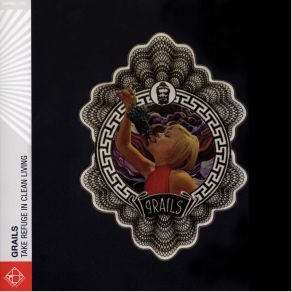Take Refuge in Clean Living
Download links and information about Take Refuge in Clean Living by Grails. This album was released in 2013 and it belongs to Rock, Indie Rock, Progressive Rock, Alternative, Psychedelic genres. It contains 5 tracks with total duration of 32:29 minutes.

|
|
|---|---|
| Artist: | Grails |
| Release date: | 2013 |
| Genre: | Rock, Indie Rock, Progressive Rock, Alternative, Psychedelic |
| Tracks: | 5 |
| Duration: | 32:29 |
| Buy it NOW at: | |
| Buy on iTunes $4.95 | |
| Buy on Amazon $4.45 | |
| Buy on Songswave €0.92 | |
| Buy on iTunes $4.95 | |
Tracks
[Edit]| No. | Title | Length |
|---|---|---|
| 1. | Stoned At the Taj Again | 7:34 |
| 2. | Ptsd | 6:51 |
| 3. | 11th Hour | 4:08 |
| 4. | Take Refuge | 8:06 |
| 5. | Clean Living | 5:50 |
Details
[Edit]The Grails fifth full-length picks up right where Burning Off Impurities left off and goes even further. Their instrumental land of improvised grooves, trance-like drones, Eastern modes and melodies, psychedelic textures, and above all, their very forward moving post-rock music, is unlike Pelican's or Mogwai's; it doesn't resemble Isis' or Godspeed You Black Emperor!'s. The Grails' brand of guitar-centric instrumental music is not given to simply building crescendos. Instead, it is interested in exploring the outer reaches of groove, space, and texture. It seems to be focused on how much they can pack into a given tune to make things like space and time disintegrate in the mind of the listener. Here, 32 minutes can seem like hours, or they can go by in what feels like a heartbeat. Take Refuge in Clean Living contains five tracks, four of which are originals. The lone cover — an unrecognizable version of the Ventures' "11th Hour" — is cut three, and is the album's hinge piece on both CD and vinyl (it divides side one and side two). "Stoned at the Taj" is a brilliant opening track. It begins with some spacy telegraphic radio sounds, a big, bad dirty bassline (fuzztone on stun), and a pulse; these build with strummed, fingerpicked electric guitars playing different melodies, and a blues lick or two unhurriedly upping the tension, and then, as the body of the repetitive melody becomes more pronounced, the drums thunder in, waves of organ, a Turkish saz, feedback, wah-wah pedals, and harpsichords all layered on top of one another, just washing over the listener in a pure stoned groove. As the track develops, sounds and instruments coming out from in back of that monster thump and weave it into near silence with just a couple of keyboard lines holding a drone chord to keep the focus. The nocturnal psychedelia moves toward an Eastern mode but it never loses its center. The guitars, more delicate than before, are perhaps even more mysterious and menacing. When it breaks open a second time, it's an entirely different setting for the bass, playing a new line and creating a different groove that just naturally evolves in both tempo and dynamic. The speed and intensity are logical extensions of the groove itself. This is one of those tracks that you can play a thousand times and still not hear everything in it.
In fact, the track establishes such a flipped-out spiral that the creeping in of "PTSD," the set's second cut, can feel like an extension of the first. Lines between dimension, dynamic, and texture blur. This one builds from the most spectral of elements as well, and when it does enter itself fully, it doesn't resemble "Stoned at the Taj" at all: it's an utterly different series of interplaying instruments, feedback drones, wafting electronics, and percussive elements. Electric guitars, saz bass and drums all move into and through one another with a single phrase fingerpicked throughout as a tonal center for everything — and it certainly feels like improvisation more than just production — that comes next. The minor-key breathing of a beautiful harmonium combined with some tom-tom patterns brings the title track into focus and feels more like a sitar cum rock track than anything else here, or anything in the band's catalog. The rock effects enter shortly after the cut begins, but they never quite eclipse the theme, even though they create a rather stretched to the breaking point variation on the theme. The throbbing bassline, fat guitars, horns, two drums, hand percussion, and sonics offer something akin to a stoner rock version of Popol Vuh's soundtrack work for Werner Herzog. The organ interlude signifies another shift in melody and direction: seamless, sprawling, free; never giving way to excess or studied post-rock "affect." The final cut is called "Clean Living," and is unlike anything else here. It is pure, dense freak-out space, filled with a controlled chaos before the melody — played on a faraway sounding, out of tune piano — emerges. With added strings, bass, and echo, it becomes counter to the chaos it began in, and becomes an enveloping cave of beautiful, harmonious sound, and despite its many dissonant elements, it creates a place of reverie, safety, and the illusion of timeless bliss. Not bad for an instrumental rock album, eh? And if at times Take Refuge in Clean Living lacks the all-encompassing flip-out power quotient of 2007's Burning Off Impurities, it more than makes up for it in the kind of risk-taking experimentation that a listener welcomes and can continue to listen to years after she first encounters it. The Grails are at the very top of their game; they define in the very best sense what the term "post-rock" means. Theirs is music of possibilities, not dead ends.